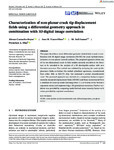Characterization of non‐planar crack tip displacement fields using a differential geometry approach in combination with 3D digital image correlation
| dc.contributor.author | Camacho‐Reyes, A | |
| dc.contributor.author | Vasco‐Olmo, JM | |
| dc.contributor.author | James, Neil | |
| dc.contributor.author | Diaz, FA | |
| dc.date.accessioned | 2022-04-29T11:42:09Z | |
| dc.date.available | 2022-04-29T11:42:09Z | |
| dc.date.issued | 2022-05 | |
| dc.identifier.issn | 1460-2695 | |
| dc.identifier.issn | 1460-2695 | |
| dc.identifier.uri | http://hdl.handle.net/10026.1/19122 | |
| dc.description.abstract |
<jats:title>Abstract</jats:title><jats:p>This paper describes a novel differential geometry method that is used in combination with 3D digital image correlation (3D‐DIC) for crack tip field characterization on non‐planar (curved) surfaces. The proposed approach allows any of the two‐dimensional crack tip field models currently available in the literature to be extended to the analysis of a 3D developable surface with zero Gaussian curvature. The method was validated by analyzing the crack tip displacement fields on hollow thin‐walled cylindrical specimens, manufactured from either 304L or 2024‐T3 alloy that contained a central circumferential crack. The proposed approach was checked via a comparison between experimentally measured displacement fields (3D‐DIC) and those reconstructed from a modified 2D crack tip model (utilizing either 2, 3, or 4 terms of the William's expansion series) and implementing a 3D geometrical correction. Further validation was provided by comparing model‐derived stress intensity factors with values provided by empirical correlations.</jats:p> | |
| dc.format.extent | 1521-1536 | |
| dc.language | en | |
| dc.language.iso | en | |
| dc.publisher | Wiley | |
| dc.subject | 3D-DIC | |
| dc.subject | crack tip field | |
| dc.subject | curved circumferential crack | |
| dc.subject | differential geometry | |
| dc.subject | non-planar surface | |
| dc.title | Characterization of non‐planar crack tip displacement fields using a differential geometry approach in combination with 3D digital image correlation | |
| dc.type | journal-article | |
| dc.type | Journal Article | |
| plymouth.author-url | https://www.webofscience.com/api/gateway?GWVersion=2&SrcApp=PARTNER_APP&SrcAuth=LinksAMR&KeyUT=WOS:000763793100001&DestLinkType=FullRecord&DestApp=ALL_WOS&UsrCustomerID=11bb513d99f797142bcfeffcc58ea008 | |
| plymouth.issue | 5 | |
| plymouth.volume | 45 | |
| plymouth.publication-status | Published | |
| plymouth.journal | Fatigue and Fracture of Engineering Materials and Structures | |
| dc.identifier.doi | 10.1111/ffe.13686 | |
| plymouth.organisational-group | /Plymouth | |
| plymouth.organisational-group | /Plymouth/Faculty of Science and Engineering | |
| plymouth.organisational-group | /Plymouth/Faculty of Science and Engineering/School of Engineering, Computing and Mathematics | |
| plymouth.organisational-group | /Plymouth/Users by role | |
| plymouth.organisational-group | /Plymouth/Users by role/Academics | |
| dcterms.dateAccepted | 2022-02-16 | |
| dc.rights.embargodate | 2022-4-30 | |
| dc.identifier.eissn | 1460-2695 | |
| dc.rights.embargoperiod | Not known | |
| rioxxterms.versionofrecord | 10.1111/ffe.13686 | |
| rioxxterms.licenseref.uri | http://www.rioxx.net/licenses/all-rights-reserved | |
| rioxxterms.type | Journal Article/Review |


